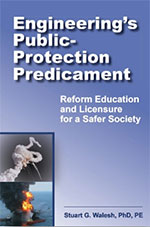
By quickly paging through a book, a potential reader can sense the book’s themes, breadth, depth, and tone. Author Walesh tried to do that for you by paging through Engineering’s Public-Protection Predicament and selecting the texts below for your consideration. For your convenience, he arranged the excerpts in these four categories: celebration, education, licensure exemptions, and engineering as a profession.
Celebration
I deeply appreciate engineering’s service to society, value the thrills experienced in creating and building useful results, and marvel at engineering’s massive contribution to our nation’s quality of life. I have also been uplifted by the constant stream of very bright young people coming into engineering with whom I worked in practice and education for decades.
I trust that learning more about some of America’s best engineering efforts and experiencing a sample of its most accomplished engineers—matchless projects and heroic engineers—stimulates you to look forward, in a broad sense, to an even better version of U.S. engineering.
A community of engineers that can create … amazing technical results and develop … amazing individuals can, if it so wills, reform, correct weaknesses, and create what could be the greatest profession.
Education
ASCE began work to broaden and deepen the formal education required to sit for engineering licensure exams across the United States. NSPE and NCEES erratically supported that effort and 11 engineering societies, the ASEE Dean’s Council, and the ACEC strongly resisted it.
For all the good ASEE does, education and experience for licensure are, at best, of marginal interest.
NCEES members, apparently aligned with licensure-exemption employers, have opposed raising the education bar. Therefore, the council retains the basic structure of its nine-decade-old Model Law, which still requires only four years of post-high school education.
Consider the irony. Engineering was the first major occupation in the United States to establish formal education but now has the least formal education for licensure compared to the [17] listed licensed professions.
Without ASCE being a burr under the U.S. engineering’s education-for-licensure saddle, the engineering education horse may plod on with its two-century-old, four-year post-high school structure and its corresponding nine-decade-old Model Law requirement.
Seek opportunities…to tell stories about engineers to engineers and, even more importantly, to others. Take your listener or reader way beyond the engineer as someone who is “good at math and science” or “knows how to fix things.”
The gap created by the broader and deeper post-high school education of all professions relative to engineering gives members of the former an edge as they begin to practice their professions and pursue whatever they define as success and significance in life.
Ask lots of questions, within and outside of your classes. The best ones…are first “why?” and then “how” do we do this or that? I have gradually developed the view that the smartest and most productive person in the room, whether it is the classroom or the boardroom, is often the one who talks the least and asks the most questions.
Licensure Exemptions
NSPE endeavors to eliminate licensure exemptions as revealed, in part, by aspects of its Issues and Advocacy program.
As long as massive engineering licensure-exemption laws exist, ABET will, with minor exceptions, continue to lack interest in professional licensure.
NAE’s mission, history, and programs suggest no interest in engineering licensure and little interest in working to reform the education and experience needed for licensure.
If a surgeon, lawyer, or veterinarian errs, the consequences are limited to one or a few people or pets. If engineering fails, like in the Boeing 737, Merrimack Valley gas distribution system, BP oil spill, or General Motors ignition switch tragedies, dozens or hundreds of people are killed, injured, or otherwise harmed. Legal but senseless.
The public holds engineers in high regard and strongly supports licensing of professionals. However, the public does not fully understand the personal impact of engineering, and the public is unaware of the way omnipresent engineering licensure exemptions deny them the protection they could and should have.
Washington State protects the public from poor or failed hair stylings or haircuts. There are no exemptions—in contrast with the state’s engineering licensure law. Washington seems more concerned with flawed hair design or barbering—a bad hair day—than with flawed aircraft—a bad flying day.
Hospitals…have licensed physicians in “responsible charge” of surgery. Law firms…have licensed attorneys in “responsible charge” of legal services. Veterinary clinics…have licensed vets in “responsible charge” of neutering and spaying. Of course, they all do…However, that … is not the way U.S. engineering functions, to the public’s detriment.
When riding my bike, I am likely to suffer less harm in an accident if I am wearing a helmet, however, no guarantee. Similarly, having watched many automobile races, I know that when driving my car, my probability of injury in an accident is less if I am wearing a seat belt. PEs are the helmets and seat belts of engineering projects.
For decades, too many Americans have been killed, maimed, and injured, and much property has been damaged. Reason: Many engineering projects have not been produced under the guidance of and with engineering approved by competent and accountable licensed engineers whose paramount responsibility is public protection.
All, or even most, graduates of ABET-accredited four-year engineering programs do not need licensure. In the spirit of full disclosure and resulting benefit to graduate engineers, I suggest fully informing [potential engineering students] and their parents and advisors…about the three attractive career options: PE, engineer with license optional, and other career.
I can’t help but wonder about a potential surge in creativity and innovation if the 80 percent of U.S. practicing engineers now in the confining licensure-exemption environment were given more autonomy and control over and accountability for their efforts.
Licensure-exemption laws “handcuff” engineers, preventing them from fully applying engineering’s ideology of meeting society’s physical needs while protecting the public.

To be clear, I am not saying that all engineers should be licensed—far from it. However, I believe that PEs should lead all engineering projects that have the potential to harm the public.
When the chips are down and much is at stake, PEs are more likely to consider ethical responsibilities, especially protecting the public, than unlicensed engineers.
Engineering as a Profession
Largely because of licensure exemptions and inadequate education for licensure, the American engineering community, as a whole, is not…a profession, although some tiny segments—PE members of ASCE and NSPE—are professions. As a result, engineering has too little public influence, risks becoming less attractive to the best and brightest young people, and individuals and the nation may lose opportunities.
Beginning near the end of the twentieth century, hard-nosed analysts, mostly outsiders, weigh in. They declare that while U.S. engineering is essential and has great promise, it falls far short of being a profession and, therefore, achieving its potential. I wish for the former but come down on the side of the latter.
U.S. engineering has too small a voice and resulting public influence because it is not a profession, but rather a collection of essential and effective technological occupations.
Notes:
- Author Walesh welcomes opportunities to speak, write, or collaborate about topics related his book. Contact him at 219-242-1704 or stu-walesh@comcast.net.
- Image sources: Author and Pixabay
Learn More About Stu Walesh | Clients Served | Testimonials & Reviews
Managing and Leading Books | Tailored Education & Training
Home | Legal Notice | Privacy Statement | Site Map
Copyright © Stuart G. Walesh Ph.D. P.E. Dist.M.ASCE
Web Site Design, Hosting & Maintenance By Catalyst Marketing / Worryfree Websites |

